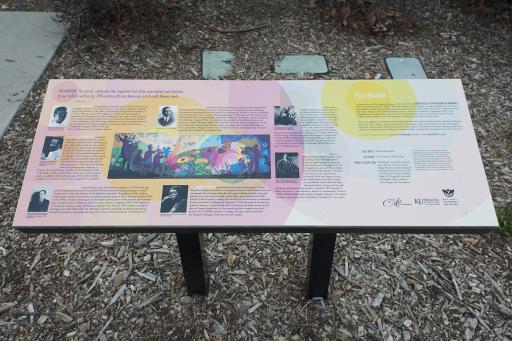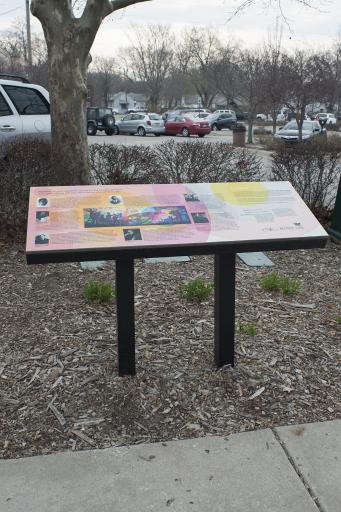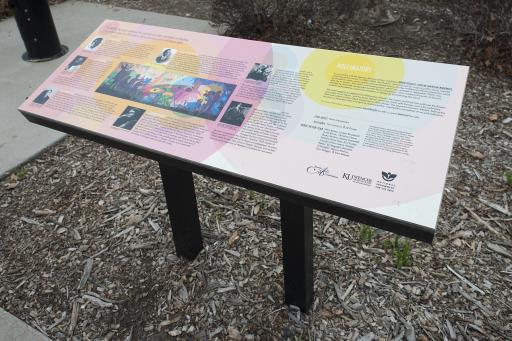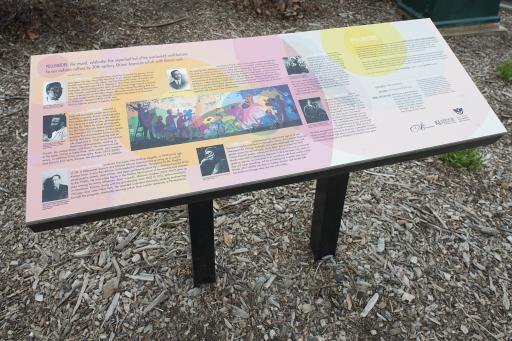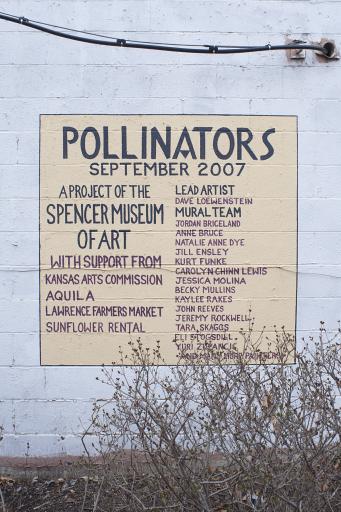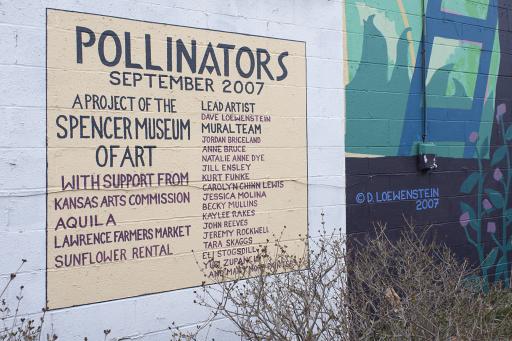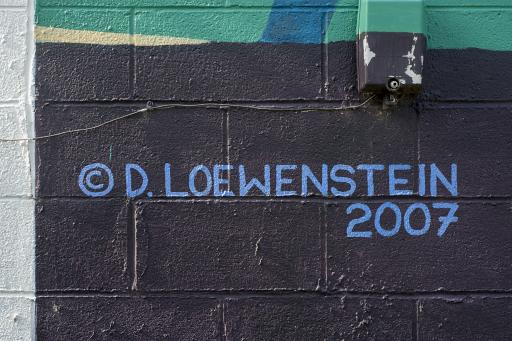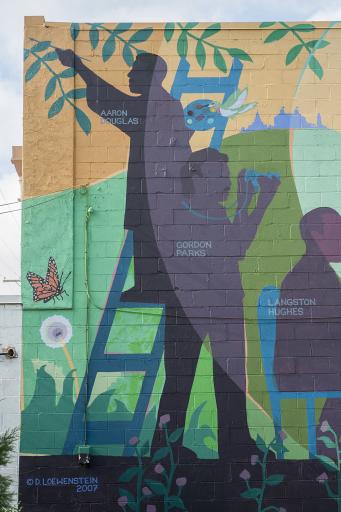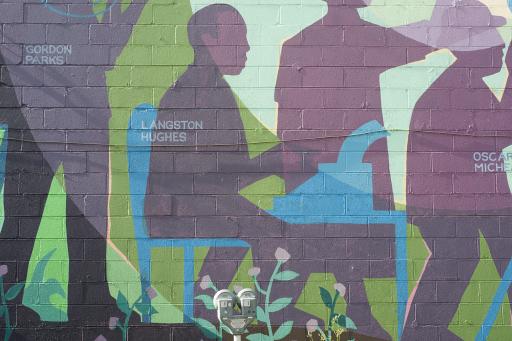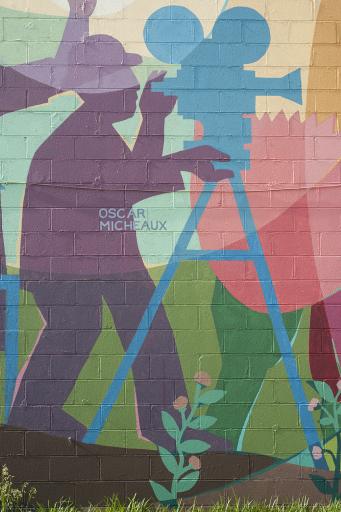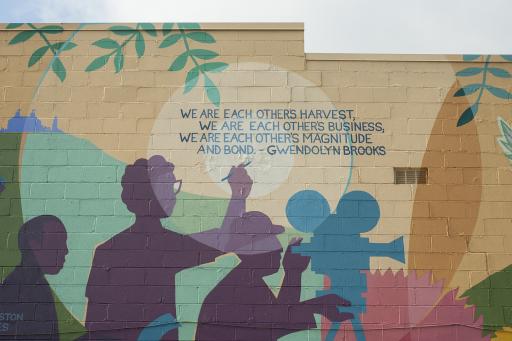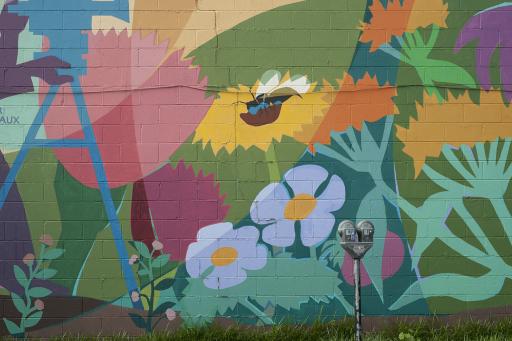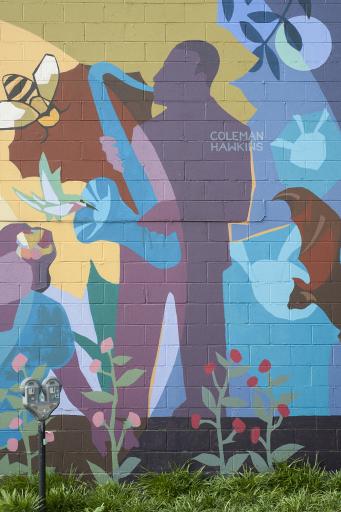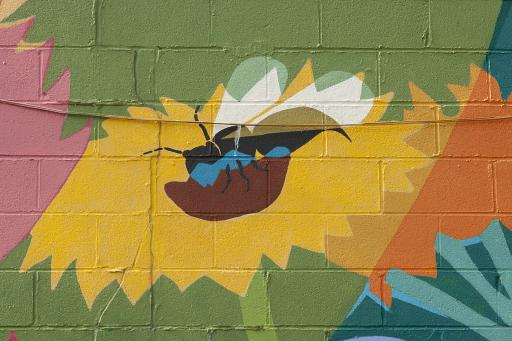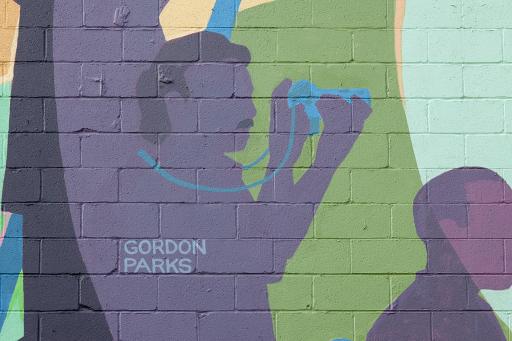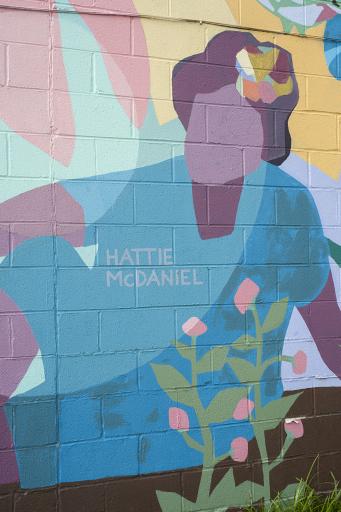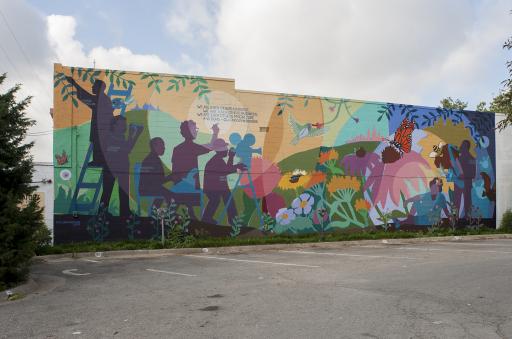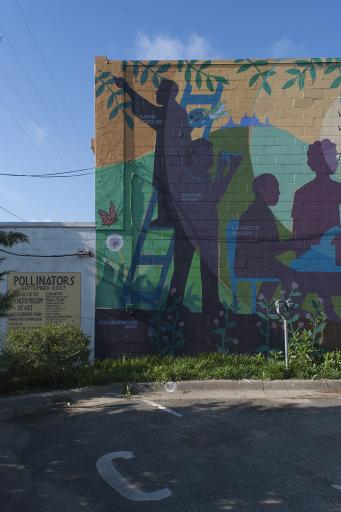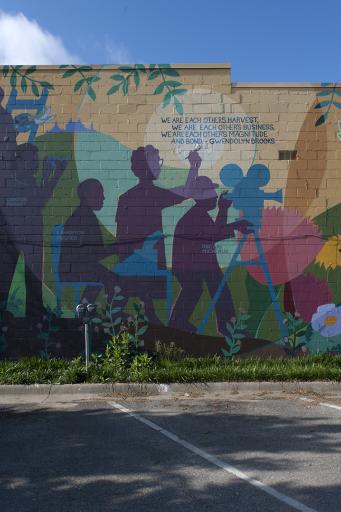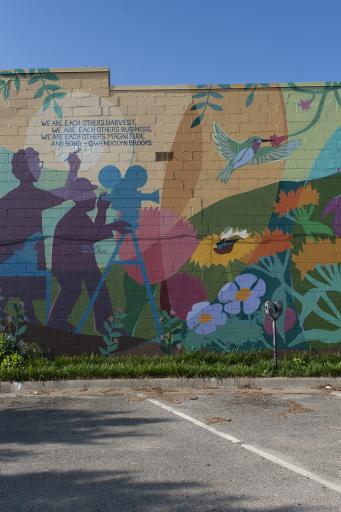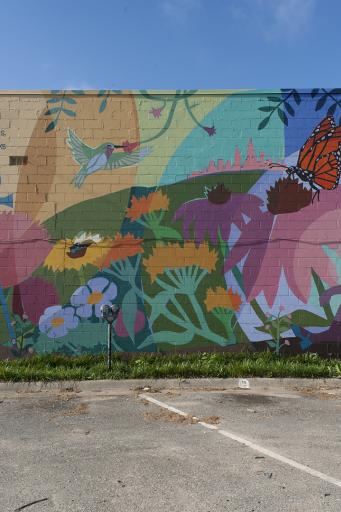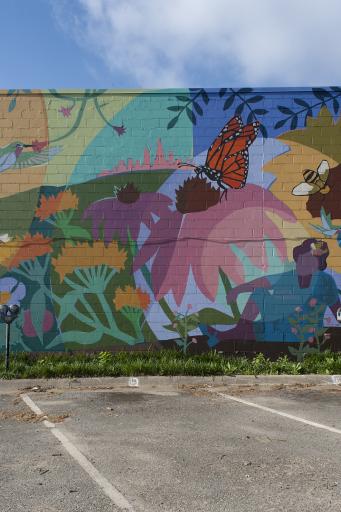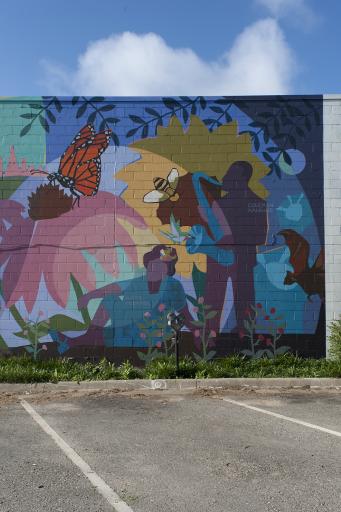Pollinators
In conjunction with the Spencer Museum of Art’s exhibition Aaron Douglas: African American Modernist, which toured the country in 2007-2008, the Museum commissioned an original public mural inspired by Douglas's artistic vision and the interconnected history of other well-known African American artists with ties to Kansas. This community-based project, which was unveiled in September 2007, was directed by nationally recognized muralist Dave Loewenstein, who involved University of Kansas students and Lawrence community members in designing and painting the mural.
The mural suggests a metaphorical relationship between the insects and birds that pollinate the flowers and crops of our region, and the seven African American artists with Kansas roots who pollinated American culture as their talents blossomed in other places. The Lawrence Farmers’ Market, held at this location on Saturdays from mid-April to mid-November, inspired this connection of art and cultivation.
For more information, please visit www.aarondouglas.ku.edu or www.spencerart.ku.edu.
Lead artist: Dave Loewenstein
Assistants: Yuri Zupancic and Jill Ensley
Mural design team: Whit Bones, Jordan Briceland, Anne Bruce, Christina Hoxie, Becky Mullins, Jeremy Rockwell, Natalie Anne Dye, Kurt Funke, Carolyn Chinn Lewis, Kaylee Rakes, Eli Stogsdill, Amanda Schwegler, Jessica Molina, Tara Skaggs, and John Reeves
XXXXXXXXXXXXXXXXXXXXXXXXXXXXXXXXXXXXXXXXXXXXXXXXXXXXXXXXXXXXXXXXXXXXXXXXXXXXX
The mural celebrates the important but often overlooked contributions to our nation’s culture by 20th-century African American artists with Kansas roots.
From left to right:
Artist Aaron Douglas overcame many obstacles to pursue his passion for art and ideas. He was one of the first artists to put African aesthetic influences and African American life, labor, and freedom at the center of modern art. In 1925, after earning a B.F.A. degree in 1922 from the University of Nebraska and teaching at the elite, all-black Lincoln High School in Kansas City, Douglas migrated to New York to join the cultural flourishing that has come to be known as the New Negro Movement or the Harlem Renaissance. He later taught art for three decades at historically black Fisk University in Nashville. Douglas (1899-1979) was born to laborer parents in Topeka, Kansas.
Photographer Gordon Parks enjoyed a long and successful career as an artist, working in poetry, fiction, autobiography, film, and ballet as well as in the medium for which he is best known, photography. During the 1940s he made photographs for the Farm Security Administration and the Standard Oil Company of New Jersey, projects that documented American life during that time. He joined the staff of Life magazine in 1949 as its first African American photographer, working in France, the United States, and Brazil. He retired from Life in the early 1970s to make films, write, paint, and compose music, in addition to his photography. Parks (1912-2006) was born in Fort Scott, Kansas, the youngest of 15 children.
Writer Langston Hughes wrote his first novel, Not Without Laughter, in 1930 at the age of 28. A bittersweet account of a fictional African American boy growing up in a small Kansas town, it won the Harmon Gold Medal for Literature. Throughout his life, Hughes wrote poetry, novels, short stories, and plays, portraying black life in America from the 1920s to the 1960s. He was a key figure in the Harlem Renaissance of the twenties and counted jazz among his many influences. Born in Joplin, Missouri, Hughes (1902-1967) grew up in Lawrence, Kansas, living with his grandmother from 1903 to 1915, before moving to Chicago and, later, New York. He attended Columbia University, studying engineering, but left the program, eventually earning a B.A. from Lincoln University in Pennsylvania.
Poet Gwendolyn Brooks published her first poem at the age of 13 and became a regular contributor to the poetry column of the African American newspaper the Chicago Defender. Her poems addressed both race and gender issues; her second book, Annie Allen, was awarded the 1950 Pulitzer Prize for poetry, making her the first African American so honored. Brooks once told Contemporary Literature, "I think the poet, if he wants to speak to anyone, is constrained to do something with those words so that they will mean something, will be something that a reader may touch." Brooks (1917-2000) was born in Topeka, Kansas, and moved with her family to Chicago when she was still a baby.
Filmmaker Oscar Micheaux was the first African American to produce a feature-length film. As a young man, Micheaux moved to South Dakota to homestead and take up farming. He wrote an autobiographical novel called The Homesteader. He then turned to filmmaking, producing his first movie, based on The Homesteader, in 1919. Because film studios of the time would not hire a black producer, Micheaux formed his own studio, writing, producing, and directing at least 43 films in his lifetime. He was also the first African American to produce a “talkie.” Micheaux (1884-1951) was born to former slaves in Metropolis, Illinois. His uncles lived in Great Bend, Kansas, and his parents moved to Great Bend when he was a young man. Though he didn’t live in Great Bend for an extended period, he visited regularly and is buried in the cemetery there.
Actress Hattie McDaniel toured with a minstrel troupe as a young woman and did occasional radio shows until the stock market crash of 1929. Unable to find work performing, McDaniel took a job as a restroom attendant at a night club in Milwaukee. Her singing voice eventually earned her a spot on stage. In 1931, she moved to Los Angeles and again found work on the radio. Her screen debut came in the 1932 film The Golden West, and her first major role was alongside Will Rodgers in Judge Priest (1934). In 1940 McDaniel became the first African American to win an Academy Award, honored for her role as Mammy in Gone with the Wind (1939). McDaniel (1895-1952) was born in Wichita, Kansas.
Musician Coleman Hawkins was an influential tenor saxophonist who grew up playing music. He began piano lessons at age five and was playing at school dances by the age of 12. His first regular job was with the orchestra at the Twelfth Street Theater in Kansas City. There he was “discovered” by Mamie Smith and began touring the United States and later, Europe. His uninhibited improvisational style changed the face of jazz and brought the tenor saxophone to the forefront. Hawkins' 1939 version of ''Body and Soul'' is considered an American masterpiece. Hawkins (1904-1969) finished high school in Topeka, Kansas, and studied harmony and composition at Washburn University for two years.
XXXXXXXXXXXXXXXXXXXXXXXXXXXXXXXXXXXXXXXXXXXXXXXXXXXXXXXXXXXXXXXX
The Spencer Museum of Art extends special thanks to Black Hills Energy, 2007 Lawrence Farmers’ Market Board of Directors (Richard Bean, vice chair; Mary Cox, board liaison; Jill Elmers, treasurer; Terri Gibbs; Brian Henry, chair; Jerry Jost, secretary; Amy Saunders; Mercedes Taylor-Puckett, market coordinator), Sunflower Broadband, the City of Lawrence, Lawrence Cultural Arts Commission, and the Kansas Arts Commission, a state agency, and the National Endowment for the Arts, a federal agency, for making Pollinators a reality.

